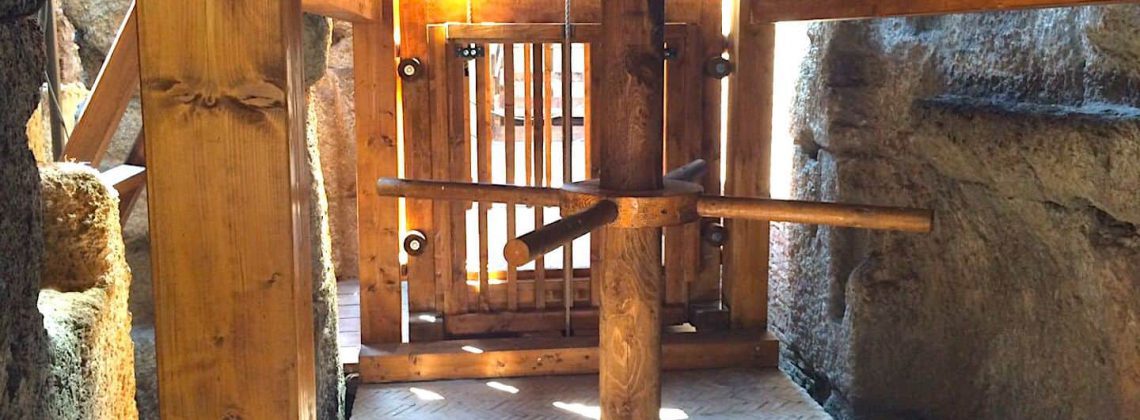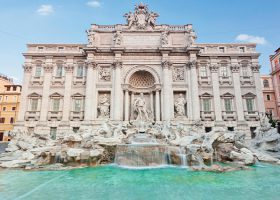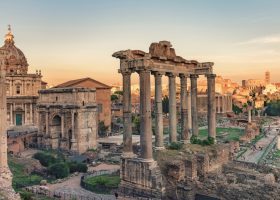The Colosseum is not only one of the ancient wonders of the world but it’s synonymous with Rome today. This massive amphitheater has been fascinating us for the last 2,000 years. But how much do you really know about the Colosseum? In this article, discover some cool Colosseum facts that’ll make your visit that much more meaningful.
Pro Tip: Planning your visit to the Colosseum? Bookmark this post in your browser so you can easily find it when you need it. See our Colosseum guide for more planning resources, our top-rated Colosseum tours for a memorable trip, and how to see Rome in a day.
19 Astounding Facts About the Colosseum
While there were many amphitheaters built throughout the Roman empire, none of them were as big or as important as the Colosseum in the city of Rome. But how much do you really know about this structure?
Keep reading to discover some interesting and lesser-known facts about the Colosseum facts—some will even shock you! If you’re planning your visit, definitely check out our top-rated Colosseum tours. Few know this ancient structure as well as our tour guides!
Not ready to book a tour? See why a Colosseum tour is worth it.
19. It’s Real Name Is Not the Colosseum
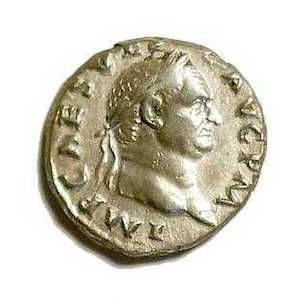
Some Colosseum facts are hard to believe, but they’re true. If you were alive 2,000 years ago and asked someone in Rome where the Colosseum was, they’d stare at you blankly. The name “Colosseum” was only used for this building much later in history.
It’s official name is the Flavian Amphitheater. It was named for Emperor Vespasianus Flavius, who built it. Even though he died before it was finished, his son took over to complete the gigantic stadium. So, the name stayed Flavius or Flavian.
18. It Only Took 8 Years To Build the Colosseum
One of the most common Colosseum facts is how long it took to build. When we’re standing in front of the building and I ask people how many years they think it took to build, they usually guess between 50 to 100 years. The fact that it was built in just eight years gives you more of an idea of how powerful the Romans were.
To be precise, Titus inaugurated the stadium after eight years, but some more construction was needed before it was finalized. His brother Domitian finished the building (after he killed his brother Titus) and it took him another two years. So, I guess we could say it took a total of really 10 years. Still quite an incredible feat, right?
Top Colosseum Tours
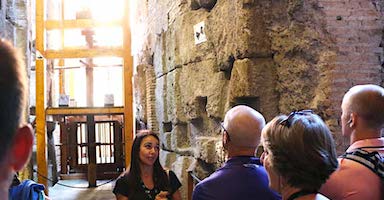
Best Seller
Colosseum Underground Tour with Roman Forum and Palatine Hill
Only 2% of visitors to the Colosseum are able to see the Underground, making tours a rare, exclusive experience. Our tours give you access to the Underground, Arena Floor, and first and second tiers—areas most people never see. Skip the line and enjoy priority access, guided by an expert who brings the Colosseum’s rich history to life. These spots sell out quickly, so don’t wait—secure your place now for this unforgettable opportunity.
See Prices
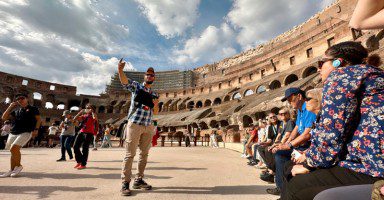
Customer Favorite
Special Access Colosseum Arena Floor Tour Through the Gladiator’s Gate
Reaching the Colosseum’s Arena Floor is no easy feat; tickets sell out quickly, leaving most visitors stuck in crowded corridors with limited views. With us, bypass the lines and enter through the Gladiator’s Gate to stand on the Arena Floor, giving you a front-row view of Rome’s nearly 2,000-year-old symbol of power and glory. With your friendly guide, uncover the Colosseum’s brutal past, then continue to the Roman Forum and Palatine Hill to explore the epicenter of ancient Roman life.
See Prices
Not ready to book a tour? Find out why a Colosseum tour is worth it.
17. The Colosseum Was Built From the Spoils of War
General Titus besieged and conquered Jerusalem in A.D. 70. He returned with gold and silver supposedly amounting to 110,000 pounds (50,000 kg). Emperor Vespasian spent that entire amount on games and mostly on building the Flavian Amphitheater.
Not only were gold and silver taken from Jerusalem, but also many slaves. There is general consensus that the Jewish settlement already in Rome paid for the freedom of many of the slaves when they arrived to Rome, but I think it’s safe to say that many would have been used in building the Colosseum as well.
16. Romans Used Gigantic Cranes To Build the Stadium
We tend to think of people who roamed the earth before us as simpletons. However, we’re talking about Ancient Rome here! A really cool fact about the Colosseum is that the stones used to build the Colosseum weighed between 20 to 50 tons. So, with humans alone it would have been impossible!
They created these cranes by tying two massive tree trunks together at the top and splitting them open at the bottom. They would then connect them to a gigantic wheel up to 25 feet (8 meters) in diameter. Then, with a hook, they would strap one end to the object being lifted and the other to the top of the trees. A sort of pendulum was created, allowing them to lift up massive weights. Genius!
15. Only Some of the Fighters Were Called “Gladiators”
One of the most unknown Colosseum facts is the origin of the word “gladiator.” The word literally means a person carrying a “gladius” or small sword. As these contests progressed over the centuries, more innovative weapons were created to make it more of a spectacle.
For example, you had a Retiarus whose weapons were a net and trident. He would throw the net over you and once you were tangled, he would strike you down with his trident.
Or, how about a Hastarius who only had a shield and spears to strike down his opponent. If you’re interested, reading more about the different types of gladiators that fought in the Colosseum.
14. 85,000 People Could Fit Inside the Colosseum
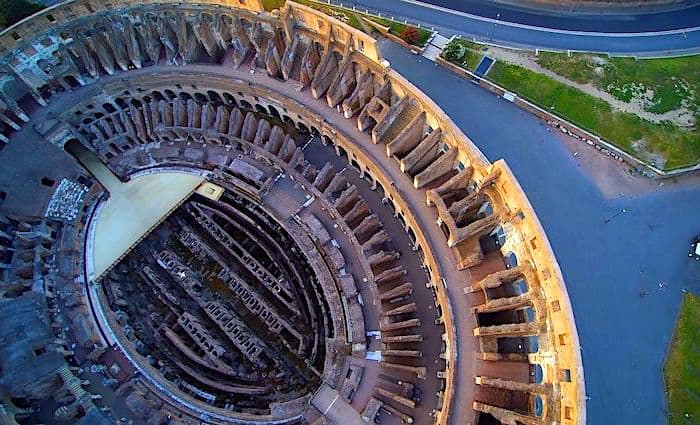
That’s right, the Colosseum is as big as our stadiums today. Archeologists put the figure at between 50,000 and 60,000 people. However, according to official records (Roman Regional Catalogues), by the end of the 4th century a whopping 85,000 people could fit in!
Even if the number is more on the low end of 50,000 people, that’s still an amazing feat and a fact that really puts the colosseum into perspective, considering we’re talking about 2,000 years ago. It is only when you stand on the Arena floor inside the Colosseum that you truly understand how big it was.
Not ready to book a tour? Check out our best Colosseum tours to take and why.
13. The Colosseum Was Built Over a Manmade Lake
The emperor Nero built a massive palace for himself called the Domus Aurea or golden house. As part of his palace, he built a gigantic manmade lake surrounded by colonnades. After Nero committed suicide and Vespasian took over, he decided to drain the lake and build a huge amphitheater on top.
As you can imagine, it’s not that easy to drain a lake of those dimensions. So, Vespasian’s engineers built a series of canals and transformed them into gigantic sewers, which allowed the water to not only drain away but also brought a steady flow of water for sewage below the Colosseum. Very clever considering 60,000 people would be using the facilities.
12. The Colosseum Was in Color
While this might come as a surprise to you, most buildings and temples were painted back in the day. Travertine, the limestone used to make the Colosseum, is a porous stone. They used a technique called scialbatura, which basically means you apply a thin layer of mortar and marble dust to prevent the the stone from deteriorating.
This would give the original white a light pink or beige color. As for the rest of the building, they painted the archways and all the statues to bring the entire complex to life.
11. There Were 80 Entrances To the Colosseum
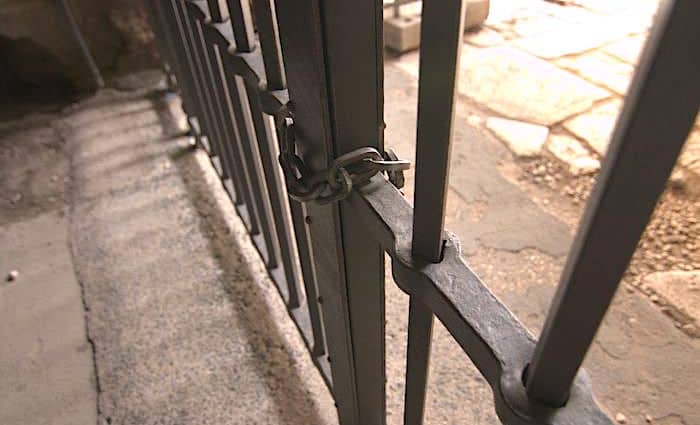
Whenever you go to a stadium today, you usually have multiple entrances on different sides of the building. Back in ancient Roman times, it was no different. The Colosseum had 80 numbered entrances.
Out of the 80 entrances, 76 were used for regular people to attend the games. They blocked off the remaining four for special purposes or special people. For example, if you join our Special Access Colosseum Arena Floor Tour, you’ll get to walk through the Gladiator’s Gate onto the Arena Floor as gladiator’s did back in the day.
Not ready to book a tour? Check out our best Colosseum tours to take and why.
10. No Concrete Was Used in the Main Structure
As unbelievable as it might sound, the outer structure of the Colosseum wasn’t put together with concrete and cement. Instead, massive blocks of stone up to 20 tons each were placed on top of each other and then iron pins stapled the rock together.
This is why when you look at the Colosseum today, it looks like a piece of Swiss cheese. The holes you see are where the iron was removed in the Middle Ages.
9. The Colosseum Hosted Mock Sea Battles
This particular event was only possible before the underground area was built—so, pretty much before Domitian finished it. They would seal up the holes and flood the entire lower area of the stadium, allowing mock naval battles to take place inside. If you’re interested, read more about the naval battles of the Coloseeum and how they made it possible.
Popular Tours from Rome
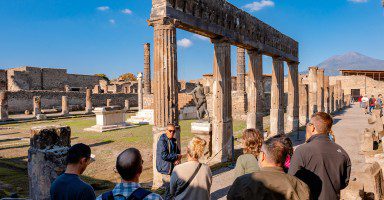
Best Seller
Unforgettable Rome Day Trip to Pompeii and Sorrento
Making a day trip from Rome to Pompeii and the Amalfi Coast can be daunting, with long travel times, complex routes, and tricky logistics to manage. Our full-day tour eliminates the stress, offering comfortbale transport straight to Pompeii. With an archaeologist guide, explore the ancient ruins without the hassle. Then, unwind with free time in Sorrento’s coastal charm. Led by a local guide and small group, this trip makes experiencing Italy’s highlights easy and enjoyable—all in one day.
See prices and more info
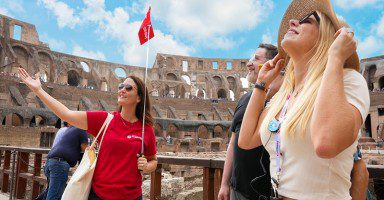
Best Seller
Rome in a Day Tour with Colosseum & Vatican Museums
Seeing the best of Rome in a single day might seem like a big undertaking, but our expertly designed tour makes it effortless with skip-the-line tickets, included transportation, and engaging guides to lead the way. In just 7 hours, you’ll visit renowned sites like the Sistine Chapel, Colosseum, Trevi Fountain, and Pantheon. With fascinating stories at every stop, you can skip the stress and immerse yourself in the vibrant heritage and culture of Rome all in one remarkable day.
See prices and more info
Not ready to book a tour? Find out if Rome tours are worth it.
8. The Colosseum Had a Dome
Nothing speaks of luxury and power more than the ability to not only build the biggest stadium in the world, but also put a dome on top of it! In Latin, the word was Velarium and, essentially, it was a huge awning on top of the Colosseum.
You have to imagine a huge sail from a sailboat. They could open the awning when it was hot or close it when they needed some fresh air. Approximately 100 sailors from the imperial fleet would control the awning.
7. The Colosseum Also Had Elevators
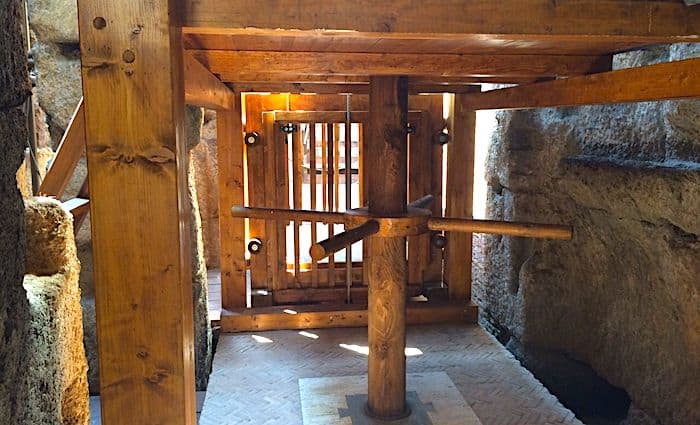
When I speak about elevators, I don’t mean elevators for the spectators to get to their seats. All they had were very steep stairs. The evevators were under the Arena Floor and they used to transport animals and gladiators up to the main fighting area in the arena.
If you saw the movie Gladiator (if not, please stop what you are doing right now and go watch it), you’ll have noticed that in battle scenes lions seemed to appear out of nowhere. This was possible due to these underground elevators. If you get special access to the Arena Floor, you’ll get to see a reconstructed elevator or trap door.
6. Not that Many Christians Were Martyred Inside
One of the main Colosseum legends is that many Christians were martyred there. To better understand this point, there are a few things we have to take into account. Most of the stories about the Colosseum that we have came down to us from Christian writers—history is written by the victors.
While there were undoubtedly many Christians who died in the Colosseum, it was not exclusively a Christian thing. The Romans didn’t discriminate when it came to killing people in the Colosseum. So, while Christians did die inside, so did everyone else.
5. Not Only Gladiator Fights Took Place in the Colosseum
Many people think that there were gladiator fights all day long at the Colosseum, but that wasn’t the case. The day of events was always broken down into three separate parts.
The morning would have been dedicated to the Venationes or hunting spectacles. This is when they would bring exotic animals into the arena and stage elaborate hunting scenes.
After that, there would be executions at midday in varying levels of grotesqueness. Finally, and only in the early afternoon, the gladiator events as we know them took place. As you can imagine, they were the main event.
4. There Were Women Gladiators
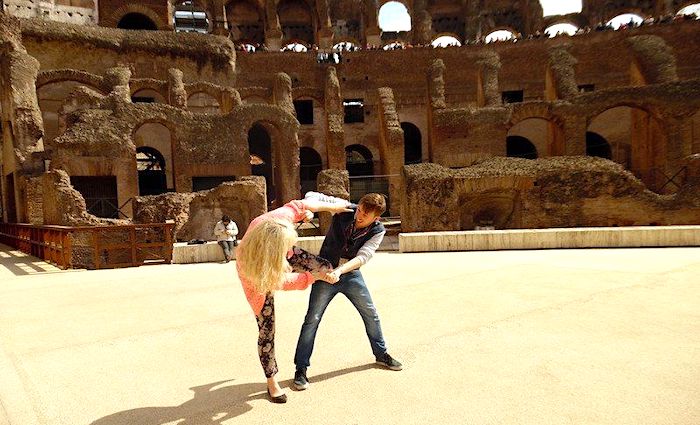
While women gladiators were not always the main event, they were quite popular in gladiator contests, especially as we moved into the later part of the empire. Interestingly, they were referred to as ludia, which means women performing in the games.
They were never referred to with the Latin word femina or “lady,” which leads us to believe that the women participating were probably from the lower classes.
Top Colosseum Tours

Best Seller
Colosseum Underground Tour with Roman Forum and Palatine Hill
Only 2% of visitors to the Colosseum are able to see the Underground, making tours a rare, exclusive experience. Our tours give you access to the Underground, Arena Floor, and first and second tiers—areas most people never see. Skip the line and enjoy priority access, guided by an expert who brings the Colosseum’s rich history to life. These spots sell out quickly, so don’t wait—secure your place now for this unforgettable opportunity.
See Prices

Customer Favorite
Special Access Colosseum Arena Floor Tour Through the Gladiator’s Gate
Reaching the Colosseum’s Arena Floor is no easy feat; tickets sell out quickly, leaving most visitors stuck in crowded corridors with limited views. With us, bypass the lines and enter through the Gladiator’s Gate to stand on the Arena Floor, giving you a front-row view of Rome’s nearly 2,000-year-old symbol of power and glory. With your friendly guide, uncover the Colosseum’s brutal past, then continue to the Roman Forum and Palatine Hill to explore the epicenter of ancient Roman life.
See Prices
Not ready to book a tour? Check out our best Colosseum tours to take and why.
3. The Event that Ended the Games
One of the saddest Colosseum facts for lovers of the arena happened on January 1, A.D. 404—the last recorded games inside the Colosseum. Saint Telemachus apparently tried to stop a fight in the Colosseum midway through and was stoned to death. At the time, Rome was ruled by Christians.
Emperor Honorius did nothing to stop the martyrdom, which happened in A.D. 39. However, the event was said to have inspired and changed him, and eventually he brought an end to the fighting.
2. The Colosseum Was Used as a Quarry
The quake of 1349 was probably good news for many who were building in Rome. Materials that were previously out of reach were now on the ground and accessible. The material was used for art, buildings, and much of what you see in Rome.
This continued for over 400 years until Pope Benedict XIV decreed in 1749 that the Colosseum was a sacred site of Christian martyrdom. From then on, it was no longer allowed to be vandalized. There are many arguments that Christians never died in the Colosseum. Regardless, Pope Benedict XIV saved the Colosseum.
1. The Pope and Tod’s Shoes Restored the Colosseum
Soon after the decree of 1749, popes began commissioning projects to restore the Colosseum. There was heavy foliage and plant life growing inside the Colosseum, which would have a tremendous negative effect on the building over time. They removed the foliage and, in 1807, a project began to reinforce the outer ring of the Colosseum, which you can see today.
Triangular brick support now reinforces the Colosseum. There were also excavations throughout the 19th century. After over 1,000 years of abusing the structure due to poor economic conditions, it was finally time to preserve it.
By the 1930s, the Colosseum looked very similar to what you see today other than some cool things like a replica of a trap door and elevator being built into the stage.
Two major cleaning projects happened in our era. From 1993 to 2000 and another in 2013, which was sponsored by Tod’s shoe company, an ultra-popular Italian designer.
Not ready to book a tour? Find out how to visit the Colosseum.
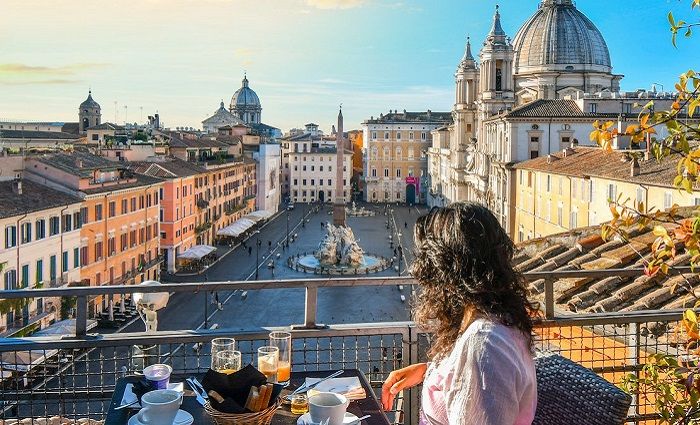
Where To Stay in Rome
Rome has a rich cultural history and many iconic landmarks to explore. Plan where to stay in the magnificent Eternal City in the best neighborhoods.

